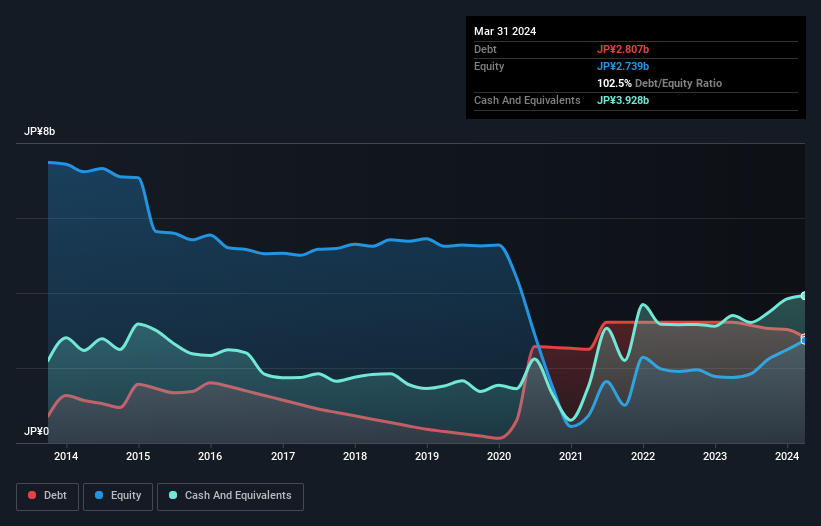
Warren Buffett famously said, 'Volatility is far from synonymous with risk.' So it might be obvious that you need to consider debt, when you think about how risky any given stock is, because too much debt can sink a company. Importantly, Ten Allied Co.,Ltd. (TSE:8207) does carry debt. But the more important question is: how much risk is that debt creating?
What Risk Does Debt Bring?
Debt and other liabilities become risky for a business when it cannot easily fulfill those obligations, either with free cash flow or by raising capital at an attractive price. In the worst case scenario, a company can go bankrupt if it cannot pay its creditors. However, a more frequent (but still costly) occurrence is where a company must issue shares at bargain-basement prices, permanently diluting shareholders, just to shore up its balance sheet. By replacing dilution, though, debt can be an extremely good tool for businesses that need capital to invest in growth at high rates of return. When we examine debt levels, we first consider both cash and debt levels, together.
Check out our latest analysis for Ten AlliedLtd
What Is Ten AlliedLtd's Net Debt?
You can click the graphic below for the historical numbers, but it shows that Ten AlliedLtd had JP¥2.81b of debt in March 2024, down from JP¥3.22b, one year before. However, its balance sheet shows it holds JP¥3.93b in cash, so it actually has JP¥1.12b net cash.

A Look At Ten AlliedLtd's Liabilities
Zooming in on the latest balance sheet data, we can see that Ten AlliedLtd had liabilities of JP¥3.37b due within 12 months and liabilities of JP¥2.09b due beyond that. Offsetting this, it had JP¥3.93b in cash and JP¥441.0m in receivables that were due within 12 months. So it has liabilities totalling JP¥1.10b more than its cash and near-term receivables, combined.
Given Ten AlliedLtd has a market capitalization of JP¥9.40b, it's hard to believe these liabilities pose much threat. Having said that, it's clear that we should continue to monitor its balance sheet, lest it change for the worse. Despite its noteworthy liabilities, Ten AlliedLtd boasts net cash, so it's fair to say it does not have a heavy debt load!
Although Ten AlliedLtd made a loss at the EBIT level, last year, it was also good to see that it generated JP¥177m in EBIT over the last twelve months. There's no doubt that we learn most about debt from the balance sheet. But you can't view debt in total isolation; since Ten AlliedLtd will need earnings to service that debt. So if you're keen to discover more about its earnings, it might be worth checking out this graph of its long term earnings trend.
Finally, a business needs free cash flow to pay off debt; accounting profits just don't cut it. Ten AlliedLtd may have net cash on the balance sheet, but it is still interesting to look at how well the business converts its earnings before interest and tax (EBIT) to free cash flow, because that will influence both its need for, and its capacity to manage debt. Looking at the most recent year, Ten AlliedLtd recorded free cash flow of 40% of its EBIT, which is weaker than we'd expect. That's not great, when it comes to paying down debt.
Summing Up
While Ten AlliedLtd does have more liabilities than liquid assets, it also has net cash of JP¥1.12b. So we are not troubled with Ten AlliedLtd's debt use. There's no doubt that we learn most about debt from the balance sheet. But ultimately, every company can contain risks that exist outside of the balance sheet. For example - Ten AlliedLtd has 3 warning signs we think you should be aware of.
When all is said and done, sometimes its easier to focus on companies that don't even need debt. Readers can access a list of growth stocks with zero net debt 100% free, right now.
Valuation is complex, but we're here to simplify it.
Discover if Ten AlliedLtd might be undervalued or overvalued with our detailed analysis, featuring fair value estimates, potential risks, dividends, insider trades, and its financial condition.
Access Free AnalysisHave feedback on this article? Concerned about the content? Get in touch with us directly. Alternatively, email editorial-team (at) simplywallst.com.
This article by Simply Wall St is general in nature. We provide commentary based on historical data and analyst forecasts only using an unbiased methodology and our articles are not intended to be financial advice. It does not constitute a recommendation to buy or sell any stock, and does not take account of your objectives, or your financial situation. We aim to bring you long-term focused analysis driven by fundamental data. Note that our analysis may not factor in the latest price-sensitive company announcements or qualitative material. Simply Wall St has no position in any stocks mentioned.
Have feedback on this article? Concerned about the content? Get in touch with us directly. Alternatively, email editorial-team@simplywallst.com
About TSE:8207
Ten AlliedLtd
Together with its subsidiary, engages in the food service business in Japan.
Adequate balance sheet with questionable track record.
Market Insights
Community Narratives



